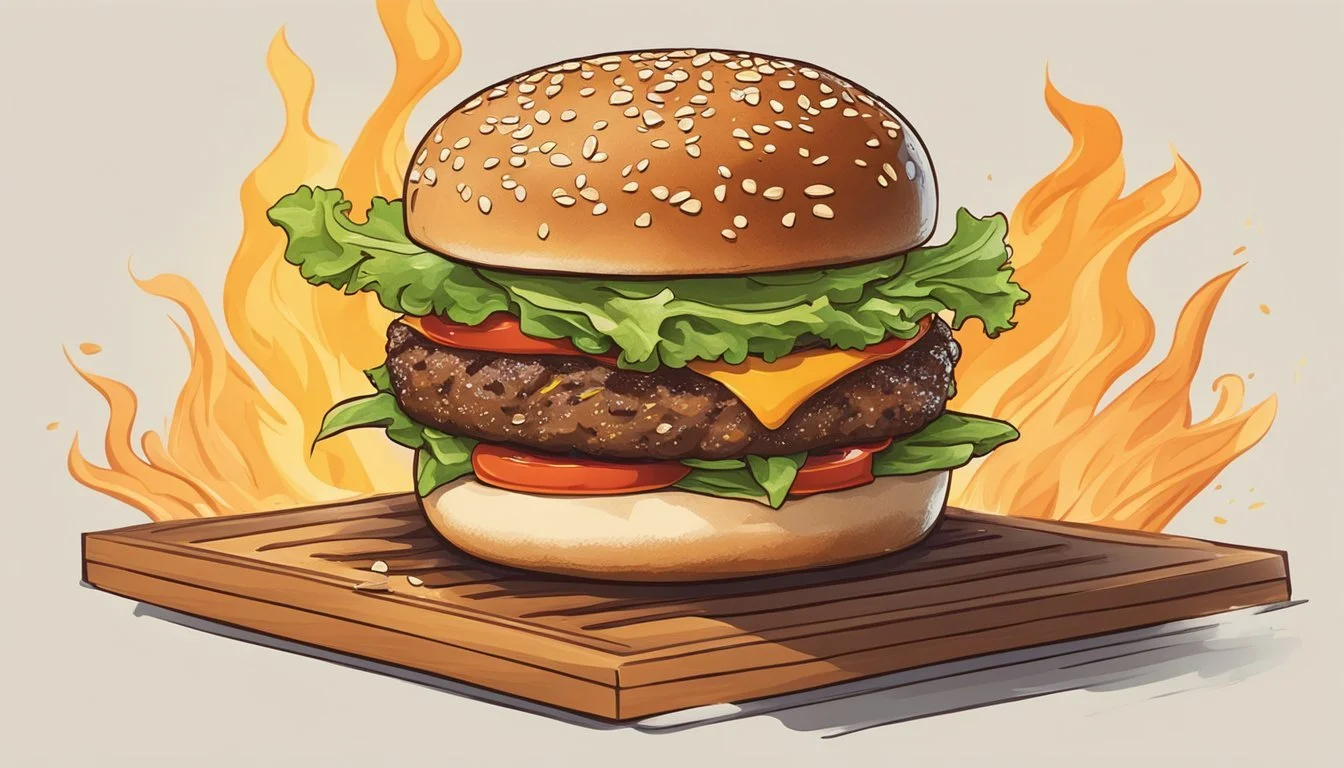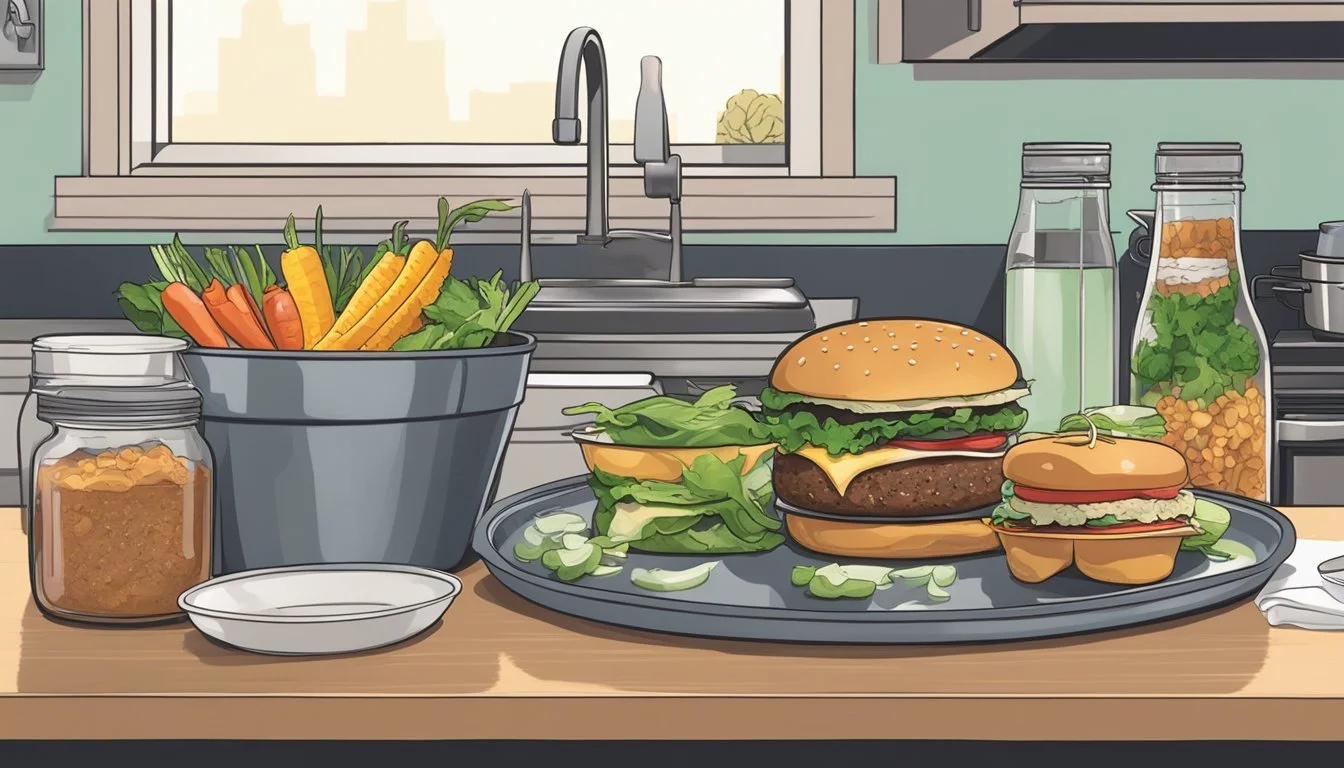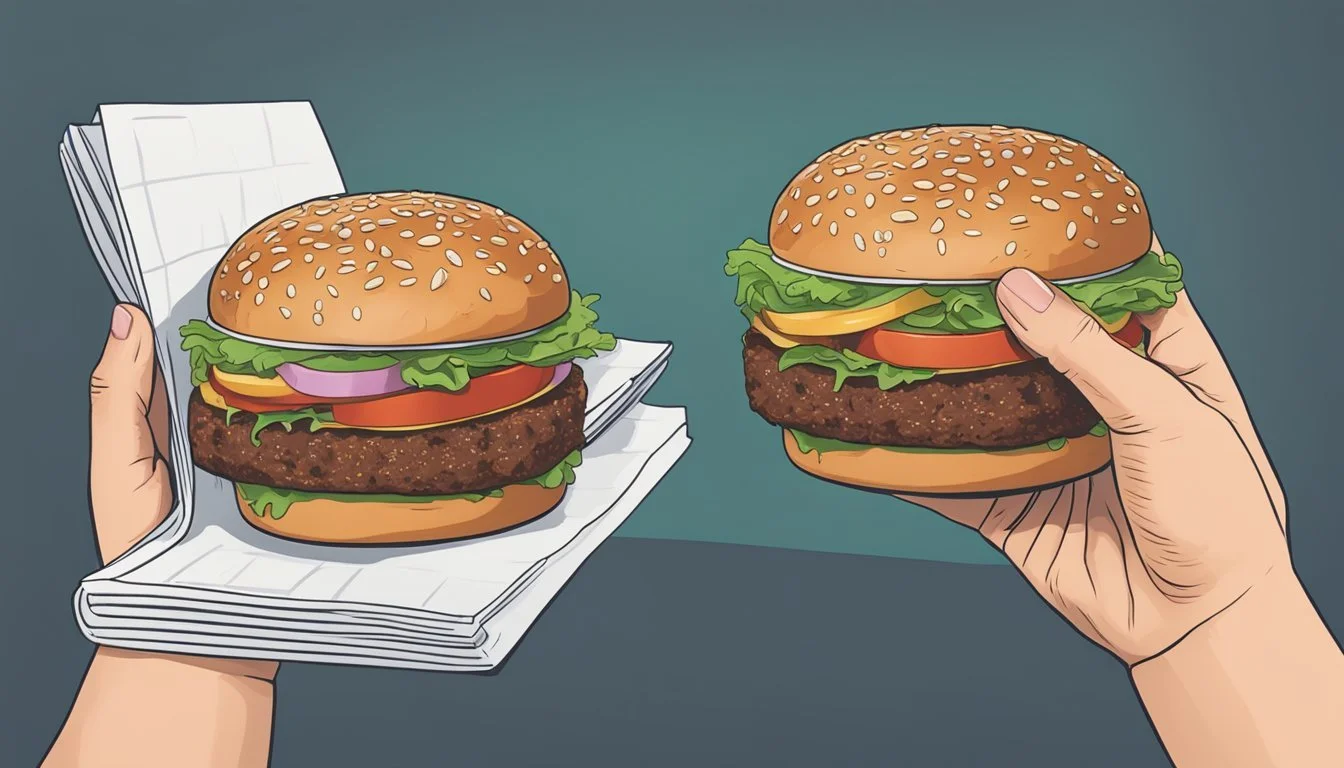How to Cook Impossible Burger
Mastering Plant-Based Perfection
Impossible Burger has revolutionized plant-based eating by offering a vegan alternative that closely mimics the taste and texture of beef. This innovative product allows home cooks to create delicious, meat-free meals without sacrificing flavor or satisfaction.
Cooking Impossible Burger is simple and versatile, requiring only 2-3 minutes per side on a hot surface such as a grill, skillet, or griddle. The patties can be seasoned just like traditional beef burgers and adapt well to various cooking methods. For the best results, a light coating of oil on the cooking surface helps prevent sticking and promotes a desirable sear.
Chefs and home cooks alike appreciate the flexibility of Impossible Burger in recipes. It can be used in classic burger preparations or incorporated into dishes like tacos, meatballs, and stir-fries. The key to success lies in treating it similarly to ground beef while adjusting cooking times to ensure optimal taste and texture.
What Is an Impossible Burger?
The Impossible Burger is a plant-based patty designed to mimic the taste and texture of beef. Created by Impossible Foods, this innovative product aims to provide a sustainable alternative to traditional meat burgers.
At its core, the Impossible Burger is made from plant-based proteins, primarily soy. It also contains heme, a molecule found in both plants and animals, which gives the burger its meat-like flavor and appearance.
Unlike conventional veggie burgers, the Impossible Burger is crafted to appeal to meat-eaters as well as vegetarians and vegans. It "bleeds" and sizzles on the grill, much like a beef patty.
The Impossible Burger boasts a nutritional profile similar to ground beef. It provides protein, iron, and vitamin B12, making it a viable option for those seeking to reduce their meat consumption without sacrificing nutrients.
Key ingredients in the Impossible Burger include:
Soy protein
Coconut oil
Sunflower oil
Potato protein
Methylcellulose
Yeast extract
Vitamins and minerals
This plant-based alternative has gained popularity in restaurants and grocery stores, offering consumers a more environmentally friendly option compared to traditional beef burgers.
Nutritional Profile
The Impossible Burger offers a plant-based protein option with a nutritional profile comparable to beef. It provides essential nutrients while reducing cholesterol and saturated fat intake.
Calories and Protein Content
An Impossible Burger patty contains 240 calories and 19 grams of protein per 4-ounce serving. This protein content is similar to that of traditional beef burgers, making it a suitable alternative for those seeking plant-based options. The burger derives its protein from soy and potato sources.
Impossible Burgers are free of cholesterol and contain 14 grams of total fat, including 8 grams of saturated fat. They also provide important micronutrients such as thiamin, folate, calcium, iron, and potassium.
Comparison with Beef
When compared to 80/20 ground beef, the Impossible Burger has a more favorable fat profile. It contains less total fat (14g vs 23g) and slightly less saturated fat (8g vs 9g) per serving. The most significant difference is the complete absence of cholesterol in the Impossible Burger, compared to 80mg in beef.
The plant-based patty matches beef in protein content while offering additional benefits. It provides higher amounts of certain nutrients like thiamin, folate, and calcium. However, the Impossible Burger does have a higher sodium content than plain ground beef.
Both options have their nutritional strengths, but the Impossible Burger may appeal to those looking to reduce animal product consumption or lower their cholesterol intake.
Preparing Your Kitchen
Setting up your kitchen properly is crucial for cooking Impossible Burgers successfully. The right equipment and tools will ensure optimal results and make the cooking process smoother.
Choosing the Right Cooking Surface
A skillet or grill are excellent choices for cooking Impossible Burgers. A cast iron skillet provides even heat distribution and creates a nice sear. For grilling, ensure the grates are clean and well-oiled to prevent sticking.
Alternatively, an oven can be used for a hands-off approach. Preheat to 400°F and use a baking sheet lined with parchment paper.
Air fryers offer a quick cooking method. Preheat to 400°F and lightly coat the basket with oil.
Regardless of the chosen surface, preheat it properly before cooking to achieve the best results.
Required Cooking Tools
Essential tools for cooking Impossible Burgers include:
Spatula: A sturdy, wide spatula for flipping burgers
Tongs: Useful for handling patties on the grill
Meat thermometer: Ensures burgers reach desired internal temperature
Timer: Helps track cooking time accurately
Oil brush: For lightly coating cooking surfaces
Plate or tray: To hold raw and cooked patties
Having these tools ready before starting will streamline the cooking process. Keep a clean plate nearby for cooked burgers to rest before serving.
Cooking Techniques
Impossible Burgers can be prepared using various methods to achieve the perfect taste and texture. Each technique offers unique benefits and flavors.
Stovetop Method
Heat a skillet over medium-high heat. Place the Impossible Burger patty in the pan and cook for 2-3 minutes per side. Press gently with a spatula to ensure even cooking. The patty should develop a nice brown crust.
For a juicier burger, avoid pressing too hard. Cook until the internal temperature reaches 160°F (71°C). Add cheese in the last minute of cooking if desired.
Let the burger rest for 1-2 minutes before serving. This allows the juices to redistribute, resulting in a more flavorful patty.
Grilling Instructions
Preheat the grill to medium-high heat. Clean and oil the grates to prevent sticking. Place the Impossible Burger patties on the grill and cook for 2-3 minutes per side.
Avoid moving the patties too much to achieve perfect grill marks. Use a meat thermometer to check for doneness. The internal temperature should reach 160°F (71°C).
For added smoky flavor, close the grill lid while cooking. Brush the patties with barbecue sauce during the last minute of grilling for extra taste.
Oven-Baked Approach
Preheat the oven to 375°F (190°C). Line a baking sheet with parchment paper. Place the Impossible Burger patties on the sheet, leaving space between them.
Bake for 10-12 minutes, flipping halfway through. Use a meat thermometer to ensure the internal temperature reaches 160°F (71°C).
For a crispier exterior, broil the patties for 1-2 minutes at the end of cooking. This method is ideal for preparing multiple burgers simultaneously.
Air Frying
Preheat the air fryer to 370°F (188°C). Lightly spray the air fryer basket with oil to prevent sticking. Place the Impossible Burger patties in the basket, ensuring they don't overlap.
Cook for 8-10 minutes, flipping halfway through. The patties should be golden brown and crispy on the outside. Check the internal temperature reaches 160°F (71°C).
For cheese burgers, add cheese during the last minute of cooking. Air frying produces a crispy exterior while maintaining a juicy interior.
Seasoning and Flavor Enhancement
Seasoning Impossible Burgers enhances their taste and brings out their unique flavors. Proper seasoning techniques can elevate the plant-based patty to new heights of deliciousness.
Basic Seasoning Guide
Salt and pepper form the foundation of Impossible Burger seasoning. Sprinkle kosher salt and freshly ground black pepper on both sides of the patty before cooking. This simple step enhances the burger's natural flavors.
For added depth, incorporate garlic powder and onion powder into the mix. These common seasonings complement the plant-based patty well. Apply the seasonings evenly and gently press them into the surface.
Consider using a pre-made burger seasoning blend for convenience. Many commercial blends contain a balanced mix of herbs and spices tailored for burgers.
Advanced Flavoring Tips
Experiment with herb-infused oils to add complexity. Brush the patty with rosemary or thyme-infused olive oil before cooking. This imparts subtle herbal notes throughout the burger.
Create a custom spice rub by combining paprika, cumin, and smoked paprika. This blend adds a smoky, slightly spicy flavor profile. Apply the rub generously to both sides of the patty.
Try adding umami-rich ingredients like soy sauce or miso paste to the patty. Mix a small amount into the Impossible meat before forming the patties. This enhances the savory qualities of the burger.
For a tangy twist, sprinkle a bit of apple cider vinegar on the patty while cooking. The acid brightens the flavors and cuts through the richness of the plant-based meat.
Toppings and Condiments
Elevate your Impossible Burger with carefully chosen toppings and condiments. The right combinations can enhance flavors and textures, creating a memorable plant-based dining experience.
Classic Toppings
Start with a foundation of crisp lettuce and juicy tomato slices. Add a layer of melted cheese - vegan options work well for those avoiding dairy. Pickles provide a tangy crunch. Consider thinly sliced red onions for a sharp bite.
For texture variety, try avocado slices or crispy onion strings. Sautéed mushrooms offer an earthy umami boost. Fresh jalapeños or banana peppers can add heat for spice lovers.
• Lettuce: Iceberg, romaine, or butter lettuce • Tomato: Beefsteak or roma slices • Cheese: Cheddar, American, or vegan alternatives • Pickles: Dill chips or spears • Onions: Raw, grilled, or crispy fried
Creative Condiment Ideas
Move beyond basic ketchup and mustard. Mix mayonnaise (or vegan mayo) with sriracha for a spicy spread. Craft a special sauce by combining ketchup, mayo, and relish. Experiment with aioli variations like garlic or chipotle.
BBQ sauce adds smoky sweetness. Try Korean gochujang for a complex, spicy-sweet flavor. Guacamole or mashed avocado creates a creamy layer. For tang, consider a balsamic glaze or whole grain mustard.
• Spicy mayo: Mix mayo with sriracha or hot sauce • Special sauce: Combine ketchup, mayo, and relish • Gourmet mustards: Dijon, whole grain, or honey mustard • Unique spreads: Pesto, hummus, or olive tapenade
Serving the Impossible Burger
Once cooked, the Impossible Burger is ready to be transformed into a delicious meal. Proper assembly and complementary sides enhance the eating experience.
Constructing the Perfect Burger
Start with a toasted bun for added texture and flavor. Place the cooked Impossible patty on the bottom bun. Add fresh lettuce, sliced tomatoes, and thinly sliced onions for crunch and freshness. Cheese lovers can melt a slice on top of the patty during the last minute of cooking.
For moisture and flavor, spread vegan mayo or ketchup on the bun. Pickles add a tangy crunch. Avocado slices provide a creamy texture. For a gourmet touch, add caramelized onions or sautéed mushrooms.
Finish with the top bun, pressing gently to meld the flavors. Cut the burger in half if desired for easier handling.
Side Dish Recommendations
Classic fries complement the Impossible Burger perfectly. For a healthier option, try sweet potato fries or a mixed green salad. Coleslaw adds a refreshing crunch and balances the rich burger.
Grilled vegetables like zucchini, eggplant, or bell peppers make excellent sides. Onion rings offer a crispy, indulgent option. For a lighter choice, serve with carrot and celery sticks and hummus.
A pickle spear on the side adds a traditional touch. To round out the meal, consider corn on the cob or a small serving of baked beans.
Storage and Leftovers
Proper storage extends the life of Impossible Burger patties. Reheating leftovers correctly preserves their taste and texture.
Storing Uncooked Patties
Refrigerate unopened Impossible Burger packages for up to 10 days. Once opened, use within 3 days for best quality. For longer storage, freeze patties immediately. Wrap each patty individually in plastic wrap or wax paper before placing in a freezer bag. Remove excess air to prevent freezer burn. Label with the date and use within 3 months.
To thaw, transfer frozen patties to the refrigerator 24 hours before cooking. Never thaw at room temperature, as this can allow bacteria to grow. Cook thawed patties within 3 days.
Reheating Without Quality Loss
For best results, reheat Impossible Burger patties in a skillet over medium heat for 2-3 minutes per side. This method helps retain moisture and creates a crisp exterior. Add a small amount of oil to prevent sticking.
Microwaving is quick but can lead to a rubbery texture. If using a microwave, place the patty on a microwave-safe plate and heat in 30-second intervals, flipping halfway through. Cover with a damp paper towel to retain moisture.
Avoid reheating more than once, as this can degrade flavor and increase the risk of foodborne illness. Discard any leftovers that have been at room temperature for more than 2 hours.
Homemade Impossible Burger Recipes
Crafting plant-based burgers at home offers creative culinary options. Homemade versions provide control over ingredients and flavors while exploring versatile uses for plant-based ground meat alternatives.
Making Your Own Patties
To create homemade Impossible Burger patties, start with plant-based ground meat. Mix in seasonings like salt, pepper, and garlic powder. Form 4-ounce patties, pressing firmly to ensure they hold together.
Heat a cast-iron skillet or griddle over medium-high heat. Add a thin layer of oil. Cook patties for 2-3 minutes per side until golden brown. For a cheeseburger, add a slice of plant-based cheese and cover briefly to melt.
Serve on buns with preferred toppings such as lettuce, tomato, and vegan condiments. Experiment with different spice blends or mix-ins like finely chopped onions for varied flavors.
Alternative Dishes with Impossible Meat
Plant-based ground meat is versatile beyond burgers. It can replace traditional ground beef in many recipes. For tacos, brown the meat with taco seasoning and serve in shells with toppings.
Form meatballs by mixing the plant-based meat with breadcrumbs, herbs, and spices. Bake or pan-fry until browned. These work well in pasta dishes or as appetizers.
In lasagna, layer the seasoned meat alternative between pasta sheets and vegan cheese. Bake until heated through and bubbly. This creates a hearty, plant-based version of the classic dish.
Other options include stuffed peppers, shepherd's pie, or chili. The meat substitute adapts well to various cuisines and cooking methods.
Health and Environmental Impact
Plant-based burgers like the Impossible Burger offer potential benefits for both human health and the environment. They provide a meat-like experience while reducing resource use and greenhouse gas emissions compared to traditional beef burgers.
Health Benefits
Plant-based burgers are good sources of protein, vitamins, and minerals. The Impossible Burger contains comparable protein to beef, mainly derived from soy. It provides essential nutrients while being free of cholesterol and lower in saturated fat than beef burgers.
These meatless options can be part of a balanced diet. They may appeal to those looking to reduce animal product consumption for health reasons. Plant-based diets are associated with lower risks of heart disease and certain cancers.
The juicy texture and meaty flavor of Impossible Burgers make them satisfying alternatives for vegans, vegetarians, and flexitarians. However, they are still processed foods, so moderation is advised as part of a varied diet.
Ecological Footprint
Plant-based burgers generally have a smaller environmental impact than beef burgers. They require less land, water, and energy to produce. An analysis for Impossible Foods found their burger created fewer emissions than conventional beef.
The production of these meatless options generates lower greenhouse gas emissions. This reduced carbon footprint helps mitigate climate change impacts from food production.
Plant proteins, even when processed into burger form, typically have a lower environmental toll than animal proteins. As more people choose plant-based options, the cumulative effect could significantly reduce the food system's ecological burden.
However, some critics raise concerns about the processing and ingredients used in plant-based burgers. The environmental impact varies between brands and specific products.
Purchasing Guide
Impossible Burger patties are widely available at many grocery stores across the United States. Look for them in the refrigerated or frozen meat section, often alongside other plant-based products.
Major supermarket chains like Kroger, Safeway, and Walmart typically stock Impossible Burger. Some specialty and natural food stores also carry the product.
The plant-based patties come in 12-ounce packages containing three 4-ounce patties. Some retailers may offer bulk packages or different sizes.
Impossible Burger is certified gluten-free, making it suitable for those with gluten sensitivities or celiac disease. The main ingredients include soy protein, coconut oil, and sunflower oil.
When shopping, check the "best by" date to ensure freshness. Refrigerated patties typically last about 10 days unopened. Frozen patties can be stored for several months.
Price varies by location but is generally comparable to premium ground beef. Some stores may offer sales or promotions on plant-based products.
For those unable to find Impossible Burger locally, the company offers direct shipping through their website. This option may be more convenient for some consumers.
Remember to handle and store the product properly after purchase. Keep refrigerated patties cold and use within the recommended timeframe for best quality and food safety.









